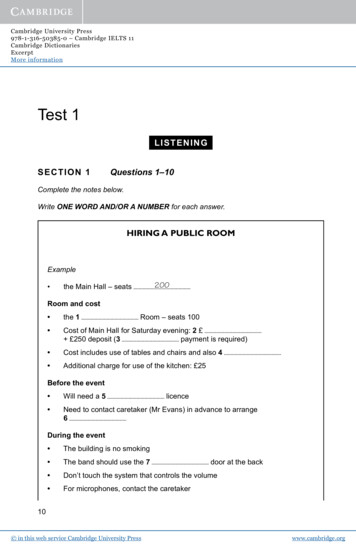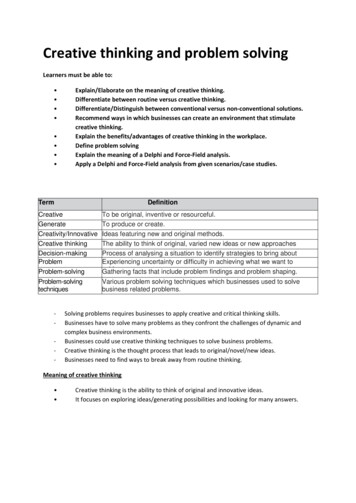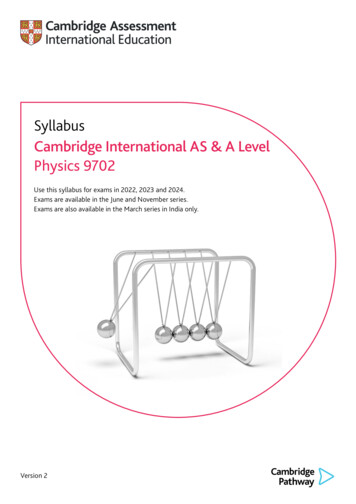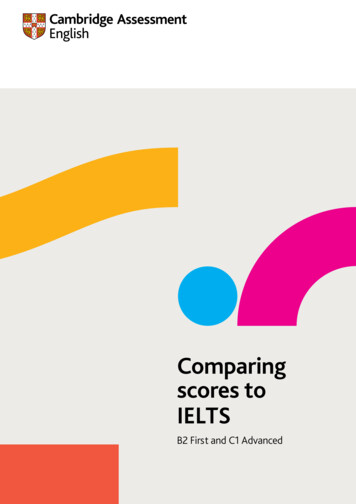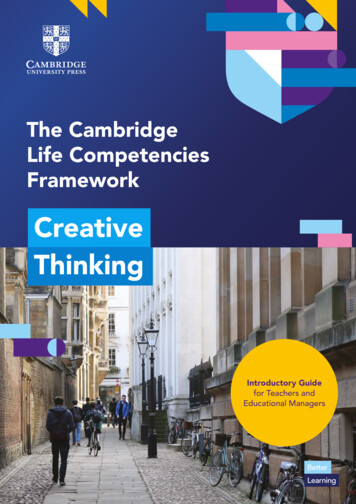
Transcription
The CambridgeLife CompetenciesFrameworkCreativeThinkingIntroductory Guidefor Teachers andEducational Managers1
Why teach Life Competencies?Our world is changing fast and we need to prepareour students with the skills and experiences that gobeyond simply learning an additional language.We see the increasing need to work together withpeople from around the world, to think creatively andsolve problems, to analyse sources more critically,to communicate our views effectively, and to maintaina positive mindset in an increasingly complex world.We understand that the engaging andcollaborative nature of the language classroomis the perfect place to develop and embedthese key qualities and the Cambridge LifeCompetencies Framework supports teachersin this challenging area.Hear from our experts2
What is the Cambridge LifeCompetencies Framework?The Cambridge Life Competencies Framework has been created in response to educators whohave asked for a way to understand how life skills, or 21st century skills, can be integrated intoEnglish language programmes. It is made up of six Competencies that describe how theseessential skills develop and vary across different stages of education, as learners grow andchange.CREATIVE THINKINGLearners actively participate in creative activities, generate new ideas anduse them to solve problems.CRITICAL THINKINGLearners identify patterns and relationships, evaluate ideas and use theseskills to solve problems.LEARNING TO LEARNLearners develop practical skills to support and take control of their learningand reflect on their own progress.COMMUNICATIONLearners choose the most appropriate language to use in differentsituations, manage conversations effectively and express themselves clearlyand confidently.COLLABORATIONLearners work well together in groups through actively taking part ingroup activities, listening to others, sharing tasks and finding solutions toproblems.SOCIAL RESPONSIBILITIESLearners recognise and describe different roles and responsibilities in avariety of groups and understand cultural and global issues.EMOTIONAL DEVELOPMENTLearners describe and manage emotions and develop positive relationshipswith others.The LearningJourneyThe Cambridge Life CompetenciesFramework supports learners at all stagesof their learning journey, from very youngpre-primary learners right through to adultsin education and at work. The frameworkmaps out how learner behaviours typicallyfound within each competency can changeand develop as learners encounter newsituations and circumstances in their lives,both within and beyond the classroom.The Cambridge Life CompetenciesFramework allows us to support learnersthroughout their education and into thecareers of the future.Pre-PrimaryPrimarySecondaryHigher EducationAt Work3
Understanding the CambridgeLife Competencies FrameworkThe Cambridge Life Competencies Framework is made up of six Competencies – Creative Thinking,Critical Thinking, Learning to Learn, Communication, Collaboration and Social Responsibilities. Eachbroad competency is broken down into Core Areas that describe these competencies in more detail.These are then analysed further into Components that, along with example Can Do Statements,describe the observable behaviours that learners are likely to be able to demonstrate by the end of eachstage of learning if they have had the opportunity to develop in these areas.CompetencyCore areasComponentsExample Can Do StatementsLinked to the competencies are the three foundation layers of the framework – Emotional Development,Digital Literacy and Discipline Knowledge. Development of skills in these foundation layers underpins allother competencies.Along with this structured breakdown, we provide example language that learners may use to expressthe actions and behaviours found in each of the Core Areas at each stage of learning. The examples usedhave been informed by both our Functional Language Phrase Bank, a collection of spoken data fromexpert speakers of English from children to adults, and input from experienced ELT practitioners fromaround the world. See this example for one Core Area within Creative Thinking at the Primary stage:COMPETENCYCREATIVETHINKINGCORE AREASImplementingideas and solvingproblemsCOMPONENTSEXAMPLE CAN DOSTATEMENTSEXAMPLELANGUAGEExperimenting withand refining ideasExperiments withI’m going to use.own ideas for doingcreative activities likecolouring, drawing andbuilding.Implementing,presenting andexplaining ideas andsolutionsUses resources toinitiate their own playor own games.Let’s use [a pen].By clearly defining these areas of development in a structured and detailed way, we can ensure that ourteaching and learning materials take a systematic approach to delivering and developing these skills inour learners, as they progress. This means that teachers can be assured that our resources bring out thebest in their students, without creating extra work.The Cambridge Life Competencies Framework is an ongoing project, evolving through stages ofvalidation and teacher feedback. Go to cambridge.org/clcf to see how you can get involved.4
What is Creative Thinking ?Creativity is a complex concept which can be defined as the tendency or ability to generate multipleoriginal and innovative ideas, alternatives, or possibilities rapidly and elaborate on them. The ideas,alternatives, or possibilities are viewed as valuable and meaningful by people other than the creator(Mumford, 2003; Restak, 2011; Sigelman & Rider, 2012). Some of the attributes of creative thinkinginclude divergent thinking, imagination, cognitive flexibility, tolerance for ambiguity or unpredictability,intrinsic motivation, and enjoyment of things previously unknown (Restak, 2011; Sigelman & Rider, 2012).We have identified three key Core Areas within Creative Thinking:CREATIVE THINKINGPreparing forcreativityGenerating ideasImplementingideas and solvingproblems Preparing for creativity includes taking part in activities that promote the development ofcreative skills. These might be drama, music and artistic tasks but also include discussions ofhypothetical scenarios, brainstorming and problem-solving activities. In addition, it involvesexploring issues that need to be solved or concepts that a learner needs to grasp, ensuring thatthey see this from multiple different perspectives. This lays the foundation for coming up withoriginal and useful ideas. Generating ideas requires generating many new options for doing something (flexibility),giving as many details as possible (elaborating), rapidly producing ideas (fluency), and comingup with ideas that do not occur to most people (originality). Implementing ideas and solving problems involves learners testing out the ideas they havegenerated and refining them. It also involves them being able to confidently present and explaintheir ideas to others.CREATIVETHINKINGPreparing for creativityParticipating in a range of creative activitiesExploring issues and conceptsConsidering multiple perspectivesFinding connectionsGenerating ideasGenerating multiple ideasElaborating on and combining ideasImagining alternatives and possibilitiesImplementing ideas andsolving problemsExperimenting with and refining ideasImplementing, presenting and explaining ideas and solutions5
Creative Thinkingacross the learning journeyCore Areas may be realised in different ways across the different stages of learning. In orderto demonstrate this, each Core Area and Component is contextualised by an example Can DoStatement. This illustrates what kinds of behaviour students who are competent in this area mightdisplay by the end of each stage of learning. These example Can Do Statements can be used as astarting point in the development of a curriculum, programme or assessment system and will vary intheir suitability for learners in different contexts. The example language is provided for teachers toconsider what kind of language they could encourage their students to use in these kinds of tasks.PRE-PRIMARYCORE AREASPreparing forcreativityGenerating ideasImplementingideas and solvingproblems6COMPONENTSEXAMPLE CAN DO STATEMENTSEXAMPLE LANGUAGEParticipating in arange of creativeactivitiesEngages in fantasy or pretend play afterlistening to a story.Let’s pretend we Exploring issues andconceptsDemonstrates curiosity by askingquestions.Where did she go?Considering multipleperspectivesParticipates in activities that involvetaking the role of familiar people (e.g.being a teacher, parent, doctor or policeofficer).I want to be [the teacher].Finding connectionsDraws pictures to represent vocabularyand familiar concepts (e.g. an animal, ahouse, a happy girl, etc.).This is [a dog].Generating multipleideasProduces more than one solution toa problem (including fun and playfulsolutions).I have another idea!Elaborating on andcombining ideasAdds some details to their ideas.And then.Imagining alternativesand possibilitiesThinks of new, imaginative roles for selfthrough play.I’m driving [on the moon].Experimenting withand refining ideasExperiments with own ideas for doingcreative activities like colouring, drawingand building.I’m going to use.Implementing,presenting andexplaining ideas andsolutionsUses resources to initiate their own playor own games.Let’s use [a pen].
PRIMARYCORE AREASPreparing forcreativityGenerating ideasImplementingideas and solvingproblemsCOMPONENTSEXAMPLE CAN DO STATEMENTSEXAMPLE LANGUAGEParticipating in arange of creativeactivitiesEngages in activities with fantasy ormystery elements.Let’s imagine we’re.Exploring issues andconceptsActively participates in investigative andexploratory tasks.I think will happen.Considering multipleperspectivesActs out the roles of various characters in Who are you?games and drama.Finding connectionsIdentifies connections between thecontents of a poem and their ownexperiences.I feel the same when.Generating multipleideasProduces multiple possibilities forsubstituting words or lines in a song orpoem.Let’s change it!Elaborating on andcombining ideasFinds new uses for objects and explainsthese ideas in detail.We can throw/drink/sit onit!Imagining alternativesand possibilitiesThinks of new, imaginative roles for selfthrough play.I’m driving [on the moon].Experimenting withand refining ideasExperiments with using different mediato make and describe their own designs.I’m going to use.Implementing,presenting andexplaining ideas andsolutionsNarrates own stories.Once upon a time.EXAMPLE CAN DO STATEMENTSEXAMPLE LANGUAGEParticipating in arange of creativeactivitiesEngages with and responds to creativeworks from art, music or literature.I love.Exploring issues andconceptsExplores different possibleinterpretations of a story or poem.I think it means.Considering multipleperspectivesConsiders the points of view of differentcharacters in a story.He probably feels.Finding connectionsCan relate the content of creative worksto own experiences.I remember when I.SECONDARYCORE AREASPreparing forcreativityCOMPONENTS7
Generating ideasImplementingideas and solvingproblemsGenerating multipleideasComes up with many options to adapt astory.Maybe we could changethe location of a story.Elaborating on andcombining ideasBuilds on others’ ideas.I really like that idea. Wecould even.Imagining alternativesand possibilitiesAsks “what if” questions to come upwith alternatives and possibilities.What if we had nomoney.?Experimenting withand refining ideasRedrafts a story or proposal in order toimprove it.This section wasn’tworking.Implementing,presenting andexplaining ideas andsolutionsPresents a solution confidently to theirpeers.The best option seems tobe.EXAMPLE CAN DO STATEMENTSEXAMPLE LANGUAGEParticipating in arange of creativeactivitiesEngages in complex creative activitiessuch as putting on an event, show orplay.How about we.?Exploring issues andconceptsAsks questions and seeks the answers tothese in order to find out more about anissue.Where did this idea comefrom?Considering multipleperspectivesDiscusses with others how characters in a What do you think willstory, novel or play might develop or act happen?as the plot progresses.Finding connectionsUses tools such as concept maps toshow conceptual relationships.These two ideas areclosely linked.Generating multipleideasActively participates in brainstormingactivities to generate new ideas.We haven’t mentionedanything about yet,have we?Elaborating on andcombining ideasBrings in prior knowledge, perhapsfrom other subjects or contexts, to solveproblems.This reminds me of.Imagining alternativesand possibilitiesQuestions and creates originalalternatives to widely-accepted ideasand theories.When it comes to.Experimenting withand refining ideasTests out new theories or models toevaluate their effectiveness and identifyareas in which they need to be refined.I need to refine.Implementing,presenting andexplaining ideas andsolutionsConvincingly presents the rationale forchoosing a particular method in theirresearch project.[A mixed-methods]approach was most suitedto my research questionsbecause.HIGHER EDUCATIONCORE AREASPreparing forcreativityGenerating ideasImplementingideas and solvingproblems8COMPONENTS
AT WORKCORE AREASPreparing forcreativityGenerating ideasImplementingideas and solvingproblemsCOMPONENTSEXAMPLE CAN DO STATEMENTSEXAMPLE LANGUAGEParticipating in arange of creativeactivitiesEngages in creative ideation activities tosolve complex problems.This is a tough problem.Exploring issues andconceptsEvaluates established workplacepractices to identify potentialimprovements.When you look closelyat.Considering multipleperspectivesAsks a range of stakeholders about theirperspective on an issue.According to.Finding connectionsUses tools such as concept maps toshow conceptual relationships.These two ideas areclosely linked.Generating multipleideasActively participates in brainstormingactivities to generate new ideas.We haven’t mentionedanything about yet,have we?Elaborating on andcombining ideasBrings in ideas and solutions from otherlife domains (e.g. social life, prior jobsor hobbies) to help understand or solvecurrent work challenges.This reminds me of.Imagining alternativesand possibilitiesOutlines how their industry or sectormight look in the future.In two years’ time.Experimenting withand refining ideasTests out possible solutions in order toevaluate their effectiveness and identifyareas in which they need to be refined.Although. worked well, itlooks like we still need towork on.Implementing,presenting andexplaining ideas andsolutionsPresents solutions convincingly tocolleagues.Taking all this intoaccount, I hope you agree is our best dent, Japan9
Creative Thinkingin the classroomCreativity is a quality that many employers look for these days in their employees, yet itsometimes runs contrary to formal education, which often depends on measurable, predetermined standards. Like many other life competencies, creative thinking is not easy toassess, evaluate or plan into the curriculum. This is because it often depends on individual,open-ended responses. It is for this reason that it should be embraced and practised more inthe classroom in a different, less rigorously-assessed and more holistic way.At the heart of creative thinking lies the notion of novelty and flexibility. However, in additionto this, it is crucial that learners reflect on the utility of their new ideas and consider howto use them to solve problems, make decisions or achieve an objective. When learnersare allowed to express themselves creatively, their motivation can increase as well as theircuriosity. Asking for a creative response can also improve learners’ self-esteem and selfawareness – giving them the confidence to reflect, question and make new associationswithout feeling anxious or fearing the judgement of their peers. There are many ways wemight embed creative thinking within our teaching, and the following sections illustrate howthis can be done at different stages of learning.Suggestions for classroom practiceThe ideas presented here are intended as a general indication of the types of activity thatmight develop this competency in the classroom, and are not a definitive list.GENERAL SUGGESTIONSIt is possible to foster creative thinking in the classroom through the use of different typesof tasks. By simply tweaking a familiar task – for example, adding a game-like element(e.g. a time or word limit) – teachers are able to introduce an element of spontaneity andunpredictability in class. This can also be done to achieved by offering learners more choice,by prompting them to use their imagination, to interact more with their peers or simply to‘think outside the box’ and encourage original ideas. Overall, whatever the age, the followingmethods for fostering a creative environment in the class are worth considering: Celebrating originality – giving praise to themdemonstrating creativity and reward out-of-thebox thinking. Asking learners questions and encouragingthem to ask questions too. By using questionsas a vehicle to dive deeper into your learners’thoughts and ideas, you are promoting creativethinking and encouraging learners to considerdifferent perspectives. Allowing learners to be playful in their creativethinking – no answers are wrong answers; theyshould celebrate diversity and even absurdity. Ensuring learners feel that the classroom isa safe space in which to engage in creativethinking.1010
PrimaryAt this level, getting learners to engage in a fantasy or a mystery element is easier than witholder learners because younger learners are often less inhibited and their attitude moreplayful. They are innately creative, and from the very early years, they use imagination ina wide variety of contexts – particularly during play activities. At this age, it is less aboutteaching creative thinking skills, and more about fostering and developing skills that arealready inherent.Creating poems and storiesWorking with a variety of texts, such as poems and stories, can be an effective way to getlearners creating new content from their own ideas or other resources. For example, in thistask called ‘I am ’ (from Goldstein’s 2008 publication ‘Working with images’ – see furtherreading page at the end of this booklet) learners: read and identify the object described by deciphering a text and then; produce a similar text by personalising an object, allowing them to conjure up new andunexpected images from the object’s material, size, shape, location, etc. without giving thegame away too early.For example, learners read the following text and guess the object. They then create theirown ‘I am .’ verse using the text as a model.I’m sometimes made of plastic.I’m usually round.I have many different shapes.But I’m often quite small.I have numbers.I often sit next to the bed.You usually use me during the week.You need me but you don’t like me.(Answer: alarm clock)This task allows learners the opportunity to ‘think outsidethe box’ and show originality. It also requires them toconsider others’ perspectives as their classmates will try toguess their object, and so the clues in their poem need tobe at the appropriate level of challenge. Even the processof guessing the object involves some creative thinkingand problem solving – teachers can get learners to worktogether on this part to negotiate and agree on possibleanswers. To add a game-like element, the teams who workout the answers the quickest could be awarded a prize, orclassmates could vote on the best ‘I am’ verse.This task can also develop divergent thinking, imagination,cognitive flexibility, and tolerance or enjoyment ofambiguity or unpredictability. These skills are necessaryto participate in creative activities and are central to thiskey competency, as established in the Cambridge LifeCompetencies Framework.Over to you 1. Try this task with your class. When planning the activity, try to make the task as open aspossible to encourage divergent thinking and imagination.2. Reflect on the activity: did it work well? If so, in what ways? Could you improve it? Whatwould you do differently next time?3. A key element of creative thinking for learners is developed through facing mystery,ambiguity or unpredictability. How could you foster this in class? Consider modifyingcourse book story materials to encourage predictions, guessing, and use of imagination inlearners, before showing them the complete stories.11 11
SecondaryLearners at this age can be more reserved when it comes to creative tasks – they may feelanxious or embarrassed to share their own thoughts and ideas with others. It is thereforeimportant for teachers to create a safe, judgement-free environment in which learners feelcomfortable and free to think and act creatively. Much of this will be done through effectivefeedback and praise of original and creative thought.Using images to develop creativity through imaginationOne way to foster an imaginative response in teenage learners is through the use of images.While the young learners task (see previous page) focused on visualising/personifying images(‘imaging’), in this task learners look at an image as the launch pad for a creative piece ofstory-telling.Traditionally, when confronted by an image, learners are asked to merely describe what theycan see. However, there are other options which allow for more creativity on the part of thelearner. For example, in an activity called ‘Who am I?’, learners create a role for a person in animage, describing their character’s feelings, and then guess the role created by others. To helplearners frame and structure their story, questions can be presented as such:Choose a person in the artwork and think about them for a few minutes:a) What’s my name? Where am I? (I am in )b) What is happening?/What has just happened to me? (I am/I have )c) What am I feeling now? (I’m feeling )d) What will happen next? (They will )e) What do I regret or what am I looking forward to? ( I regret )f) What do I wish most in the world? (If only )12
It is worth noting here the use of hypothesis in the final questions of the task, whichshould allow learners to make the sufficient imaginative leap to place themselves in theshoes of the person in the painting and imagine how they would think.Using Edward Hopper’s Nighthawks as an example painting (the image can be foundhere: www.edwardhopper.net/nighthawks.jsp), the following is an example answerfrom a secondary-school student – this could be presented to learners as a model,depending on the level and age of the learners:(A) I am at 24-hour café in a big US city. I am waiting for something important to happen. I feel tenseand nervous. (B) I am worried that they look for us, that they will hurt us. (C) We’re in trouble. (E) Weshould never do what we did, we shouldn’t took (sic) the money but we needed it. (D) Now they’relooking for us and I think they’ll catch us. (F) I wish the waiter will stop working, making that noise. Ohno! It’s so late, I can’t keep my eyes awake. I wish I was somewhere else As a follow-up, learners could discuss the reasons for their answers to the questions inorder to understand how they each interpreted the images in the painting differently,and discover different possibilities for divergent thinking. This can also help to boostself-esteem and confidence through praising each other’s originality.These tasks provide learners with different options and choices (flexibility), they requirethe learners to provide details (elaboration) and come up with ideas that do not occurto most (originality) or provide unusual angles (novelty). This is achieved within theframework of creating a story.Over to you 1. Try this task with your class. Consider letting the students choose theimage and try to give feedback on the creative efforts. This need not beoverly evaluative, but more observational.2. Reflect on the activity: Did it work well? If so, in what ways? Could youimprove it? What would you do differently next time?3. A key element of creative thinking for learners is developed throughfacing novelty. How could you foster this in class? Consider askingstudents to change the task in a way they would prefer. This activitycould also be gamified by asking students to decide on which story ismost elaborate and original.4. Students at this stage of learning are better able to understand theirown learning. Why not consider talking with them about creativethinking skills, their importance, and how to develop them. This can helpmotivate them to get involved.13
AdultLearners at this age may be more sceptical of creative thinking tasks, as they may feel they are adistraction from the more “serious” work (for example, preparing for an exam). It is therefore importantfor teachers to communicate effectively the benefits of creative thinking, as well as the objectives ofspecific creative tasks for developing their skills. Emphasis should be placed on the idea that by workingtogether, to share creative ideas and thoughts, learners will be able to learn from one another and createbetter relationships.Creating safe speaking environmentsAs an example, development of creative thinking can be undertaken in group speaking tasks in whichlearners collaborate. Indeed, creative thinking tasks work best in safe speaking environments in whichclassmates respect and value each other’s contribution, and do not fear being judged. For example, onesuch group speaking task could be the following:Think of a gift for a person visiting your country.The gift should:a) communicate something about or be typical in some way of your culture;b) be easy to transport back home;c) cost under 50 EUR, and;d) be original, different or funny in some way.It is worth noting here that the four constraints or conditions imposed by the task are in fact what makesthis appropriate for creative thinking. Without these conditions, the learners would have too muchfreedom and it would be harder for them to provide the imaginative response that is demanded of them.In order for learners to succeed in a task like this, they need to gather information, select and rank ideasand then reach a final decision to present to the class as a whole. Unlike the previous activities, this taskhas a real-life outcome – learners might have experience of making similar decisions about gifts outside14
class. This makes the task more motivating to learners as they can see the real relevance and applicabilityto their own everyday context.As an extension to the activity, groups could be invited to add a ‘what if’ scenario. After one group haspresented their ideas to another group, the other group then suggests a possible issue with the gift, e.g.“But what if the person visiting your country isn’t allowed to transport [x] on the plane?” This can lead tofurther creative thinking through the need to problem solve and consider alternative scenarios.In this task, learners collaborate to solve a particular real-world problem and make decisions to achievea specific goal or challenge. The challenge is provided by the constraints imposed by the task itself. Thetask is immersive and engages learners’ personal identities.Over to you 1. Try this task with your class. If you want to increase the challenge, add more ‘what if’ scenarios tochallenge the students’ reflexivity and flexibility.2. Consider explicitly relating this task to work-related skills: finding creative solutions, responding tochallenging and unpredictable questions etc. This task could be modified to a workplace contexttoo if that helps motivate students.3. Reflect on the activity: did it work well? If so, in what ways? Could you improve it? What would youdo differently next time?15
Creative Thinkingin learning materialsPrimaryHere, students develop their creativity by learning about acrostic poems(exercise 1) and making word lists (exercise 2). They then use their knowledgeto generate multiple new ideas when they come to write an acrostic of theirown (exercise 3).My portfoliopAn acrostic poem1Read these poems,pwhich are called acrostics. What is an acrostic?F un and laughterR unning aroundI n our playgroundE njoyN ot aloneD reamsS unshineD inosaurs were hugeI n a time far awayN o people on EarthO ne hundred millionyears agoStrongA nd dangerousU nder water and on landR eallyS cary2Work in groups. Create ideas for an acrostic poem.aMake lists of words that start with the same letter.A: apple, angry, and, art, .B: blue, before, but, .bAgree on a word which you all like, for exampleHOLIDAY, SEASIDE, CHOCOLATE, DRAGONFLY.cWrite the letters of the word in a list down the page.dAs a group, discuss words or word groups that expressthe idea of your word.Holidays are great / Hotel in the sunOn the beach / Our big tentLying on the sand / Lots of ice creamIDAY3Choose ideas and planyour own acrostic.Show your plan to yourteacher to help you.4Write your acrostic outneatly, using colours ifyou want. You can adda picture too.iTips for writersTItt’sIIt’sIt’’s alwaysalwaylway good to check yourspelling, but it’s even moreimportant if you’re writing anacrostic poem or planningpuzzles such as crosswords orwordsearches. Use a dictionaryto help you if you aren’t surehow to spell a word.Revision1616117Super Minds Level 6, page 117,ISBN 9781107458291
SecondaryHere, students practise creative thinking by imagining a scenario from theworld of work – a job interview (see ‘Life Competencies’ box). For this, theyneed to envisage a range of alternatives and possibilities, as well as generatetheir own ideas in a role play situation (exercise 10).2 Read Part B of the text. Complete the tips on how to7 Choose the correct meaning for each sentence.prepare for a job interview with the phrases below.Which tip do you think is the most important? Why?PHRASES YOU MIGHT HEAR1anything that isn’t true feel comfortableinteres
Some of the attributes of creative thinking include divergent thinking, imagination, cognitive lexibility, tolerance for ambiguity or unpredictability, intrinsic motivation, and enjoyment of things previously unknown (Restak, 2011; Sigelman & Rider, 2012). CREATIVE THINKING Preparing for creativity Partici


